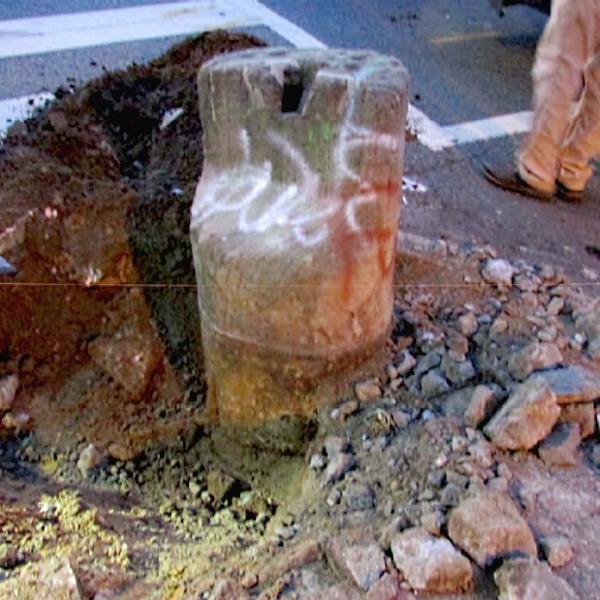
Following three years of focused community dialogue, the Fredericksburg City Council voted to relocate the Auction Block in 2019. COVID slowed its removal and in 2020, the Block became the focus of several protests in the city of Fredericksburg.
Long a topic of contention, former City Councilor Hashmel Turner advocated for the removal of the Auction Block in 2005. Years later, following the white nationalist rally in Charlottesville, Virginia in August 2017, City Councilor Chuck Frye Jr. moved for a vote to relocate the Block from its original location at the corner of William and Charles Streets on August 22, 2017. The City Council voted 6-1 (with Councilor Frye the single vote for relocation) to keep the Block where it was, but initiated a citywide conversation about the Block and representation of African American history in the city, led by the International Coalition of Sites of Conscience.
The ICSC led focus groups, brainstorming sessions, and public forums to gather community feedback and ideas for the Auction Block, and found that for many, the Block served as a symbol of a history of racial inequality and injustice in the Fredericksburg area.
One participant shared, “It is a discussion in our home – the slave block. We are multigenerational in my home – from my 85 year old mother (leave it there so ‘they’ can see it), my brothers and sisters (take it up and be educational elsewhere), my sons (bust it up). I am struck by my uncle who took a picture being up on the slave block for a Caucasian and got a quarter for it – my grandfather gave him a whipping to remind him never to do it again. Same tool, different lesson – before we would have gotten a whipping for being a slave” (published in 2018).
For another, “To me, the auction block is sacred – perhaps holy. There is so much discussion about everything else that they auctioned – not just people. To me it is a sacred space. I take a moment with God and do the cross, kiss my hand, and put my hand on the block. I fight every day for what happened there. We need to be the best we can be because of what happened there.”
And finally, “People stand on it. Treat it casually. There is no sense of respect that I’ve observed. Feel a sense of reverence. It is disturbing to me that there is this artifact that is presented in such a way that people can disrespect it. Children climb all over it. There should be a sense of reverence.”
While opinions varied widely–some wanted the Block to stay as a reminder of the pain and suffering of enslavement, some wanted it moved to a site better equipped to tell a more complete story of its history, and some wanted it removed and destroyed–ultimately the City decided to hold another vote about its proposed relocation and voted 6-1 to move it to the Fredericksburg Area Museum (FAM) on June 11, 2019.
Unfortunately, the City was not able to begin the process of relocation right away, due to several lawsuits attempting to stop its removal. Once cleared to proceed with removal, the onset of the COVID-19 pandemic once again delayed the process. The Block remained on the corner when protests against police brutality and racial injustice swept across the United States, and protestors organized demonstrations throughout the City of Fredericksburg, with the Block a particularly visible symbol of the legacies of racial injustices they intended to challenge. Around this time, the Block was spray painted with graffiti. The exact motivation is unclear: one theory is that the Block was a visible symbol of racial injustice associated with the protests, while another is that the Block’s continued presence on the street corner was a source of anger and frustration.
The city hired Dovetail Cultural Resource Group to carefully remove, transport, and clean the stone before placing it on the first floor of the FAM in October 2020.

Auction Block Removal
Archaeologists from Dovetail Cultural Resource Group, along with city staff, excavated, removed, transported, and cleaned the Block before moving it to FAM in fall 2020. Image courtesy of Dovetail Cultural Resource Group.

Protests
The Auction Block was the site of Black Lives Matter protests in 2016 and would once again serve as a focal point during protests in Fredericksburg in summer 2020. Image courtesy The Free Lance-Star.


